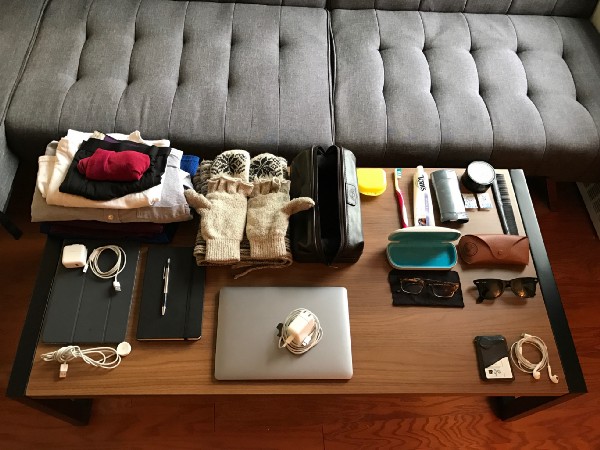Before I dive into the specifics, here are some things I’m always looking for from the tech tools I own and use regularly:
Like I just said, great stock apps. I always default to using the stock apps until they can no longer get the job done.
Storing data in the cloud as much as possible. I want as little of my data as possible to be tied to specific devices.
Great syncing. I’m almost equally likely to work from my iPad, iPhone, and MacBook. I want to be able to pick up any of them and know everything is synced and ready to go.
Reliability. I want to think about whether or not my tools are going to “work” as much as possible.
Use all the information you have about me to be as useful as possible. This means using context to be helpful in surprising ways.
Thin, light, and well made.
As simple as possible.
And now, on to some of my hopes for this year’s WWDC.
Better Siri
I would love a world where I could talk to my devices and trust they will do what I want them to do. Unfortunately, we are nowhere near that reality, yet. Siri needs to get more reliable and smarter about parsing my intention. The less “Siri syntax” I have to learn and the more I can talk like a normal human being, the better. Being able to successfully use my phone to do something other than starting or stopping a podcast without having to pull it out of my pocket would be great. #simplicity #reliability
Apple VPN
Somebody on some podcast I listen to suggested this as something that would be really interesting for Apple to offer and I’m on board. I’d pay a couple bucks a month for an Apple VPN (especially given our current political climate). I’ve used a standalone VPN off and on for the last couple years but having something built into the OS (both iOS and macOS) would really simplify things. #simplicity #reliability
Rumored “Siri Speaker”
I don’t have a huge desire for a new piece of hardware to manage, especially since I’ve been having more success using “Hey Siri” on my watch and phone recently (although, not enough success given wish list item #1). However, if Apple focused on making the speaker really good I might be interested if it could feasibly replace one or both of my SONOS speakers. I’ll trade my two SONOS speakers for a really high quality “Siri Speaker” (especially since they both sit on my desk and I live in a studio apartment — meaning I don’t need the separate rooms functionality). What would make this an instabuy for me is if it also contains wireless router functionality, thus replacing my Airport Express, too. #simplicity
Native Sleep Tracking with iPhone + Apple Watch
I’ve used AutoSleep and Sleep++ in the past but I’d love for Apple to just take this over and do it really, really well. AutoSleep is a design nightmare and Sleep++ is fine but has to be turned on manually. I’d really like to see what Apple could do with a native solution. #simplicity #stockapps
Natural Language Processing in Calendar.app
The default calendar app can handle basically everything I need but every time I move away from Fantastical 2 I miss how easy it is to create new events. I don’t want to spin dials or click through options. Let me just type (or say!) a sentence like a person and make my event from that. #simplicity #stockapps
Make Keychain a Legit Standalone Password Manager
I’ve become more interested in the past few weeks in seeing whether Keychain can truly replace 1Password. I’m not sure that it can at the moment… but it’s not too far away from being able to do so. Would love to see Apple lean into this. #simplicity #stockapps
Auto-Start Workouts on Watch
I always forget to start a running workout on my watch when I go for a run. But it knows my footfall cadence, heartrate, (and if I had a newer watch, my GPS location). Meaning, if you can tell I’m running just start a running workout! Or shoot me a push notification that says, “Yo, it looks like you’re running. Are you running?” I’ll bet it could figure out whether I’m swimming or cycling or anything else, too. Be smart about helping me capture these workouts! #simplicity #context
More Granular Notification Settings
I don’t let many notifications come through, but I would love to have control of my Do Not Disturb preferences on an app-by-app basis. Meaning, I’d love to have all my work related apps (a group that I could designate) not be allowed to send me any notifications after 6:00 PM but let my entertainment or messaging based apps keep notifying me until 10:00 PM or so. Even better granularity would be if my phone would shoot me notifications (or not) based on information from my calendar or location in the world, too. #simplicity #context
More Actions From Notifications
Again, I don’t have many notifications hitting my phone/watch… but the ones that do come through I’d love to be able to do more with. Give me more actions so that when I happen to get a notification that I can do something with I can take care of it instantly. #simplicity #context
Better Podcasts App
Every time I try to use the default podcasts app for any length of time I almost always end up reinstalling Overcast. I’m trying to figure out why since ideally a podcast app isn’t something you have to actively engage with very much. I think I just don’t like, or aren’t used to, how it’s laid out. I don’t need to be able to find new podcasts easily so I think the fact that Search, Featured, and Top Charts take up 3/5 of the menu bar real estate really throws it off. #stockapps
TV App
I appreciate the effort of centralizing my video watching experience into one app but if everything isn’t in there then it’s not really solving any problems. Make whatever deals you need to make to get everything in there… or just don’t do it. #stockapps
More Cross Platform Consistency
I don’t think macOS needs to become an iOS clone. I get that the two systems serve different purposes. But there is some really low hanging fruit that should be unified across them. Stuff like setting a timer with Siri on my MacBook. Why can’t I do that? Why is music, TV, movies, and apps all unified under iTunes on my Mac but broken into separate apps on my iOS devices. Let’s clean this up. #simplicity #reliability
iPad Hardware
I’m intrigued by the rumored new 10” iPad form factor that would exist between the original size and the honking 12” size. I think the 12” is slightly too big for me most of the time. I also think that future iPads should get some kind of super unobtrusive kickstand on the back so I can use it without a cover/case. Keep pushing thinness, too. #simplicity #thinandlight
MacBook
I like the new butterfly switch keyboards… except for the fact that I’ve had to get a stuck key fixed three times. Keep the low key travel but make it more reliable. Also, no need to make this any thinner. Keep it the same size but cram some more batteries in there. More battery life is more important than lighter or thinner at this point. #reliability
AirPods
I think AirPods in black would be delightful. I would also like them to be a touch more consistent when I tap to invoke Siri. #reliability
Apple Pencil
Make it so this bastard doesn’t roll away from me without me having to put a stupid third party clip on it. Put an on/off switch on it so the battery doesn’t die as much. And I’d be okay with making it a tiny bit thicker. #simplicity
What about you? What would make your computing life simpler and more enjoyable this year?









